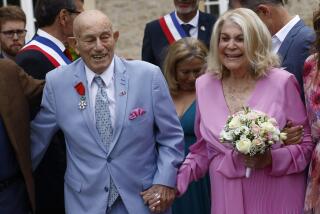At World War II museum, it’s a night to honor veterans
- Share via
NEW ORLEANS — When they were quick and strapping young men —their hair still blond, brown or black — they fought for their country.
On Saturday, their country said thank you.
Officially, the occasion was the dedication of a new $35-million pavilion at the National World War II Museum here. Tom Brokaw spoke, as did two U.S. senators and various dignitaries. Visitors studied the vintage aircraft, including a B-29 and P-51 Mustang hanging from the ceiling of the imposing U.S. Freedom Pavilion: The Boeing Center.
But the day was really about the old men.
They’re no longer quick, and many shuffled along with canes and walkers. Some rode in wheelchairs. For most, their hair, what’s left of it, has turned white.
And the hundreds attending the dedication couldn’t get enough of them.
“Thank you for your service” was heard again and again, followed by, “May I have your autograph?” and, “May I take your picture?”
The veterans, typically, were modest.
“Somebody threw a war and I showed up. Everybody showed up,” said William Blakel, 92, of Wichita, Kan.
The museum was the brainchild of author and historian Stephen Ambrose. It was originally conceived as a museum about D-day and opened on June 6, 2000, the 56th anniversary of the invasion of Normandy. In time it extended its mission to tell the story of the U.S. in World War II, both home and abroad.
As U.S. Sen. Mary L. Landrieu (D-La.) put it, Ambrose and other historians and planners believed books alone could not capture the war experience. The museum aims to “tell a story that refuses to stay on the pages,” she said.
On Saturday many stories were of family, not heroics or battle.
Jack Emerson, 89, of Metairie, La., volunteered right out of high school and went on to fly bombers over Italy. He was the eldest of three children, and the day he left for basic training in Texas “everybody was in tears.” He was told to write home every day.
And he did — for a while.
After earning his wings he was a second lieutenant, and as seen in an old photo, handsome, too. He “had a good time” as young men will do, he said. For days he didn’t write.
Then he got a telegram, serious business because only important people got telegrams. “Jack call home,” his sister wrote. “Momma’s worried about you.”
Blakel, who served in the Army Air Corps, recalled racing home to Ransom, Ill., in 1945 for Thanksgiving. He made it with three days to spare — and met his daughter for the first time. She was 18 months old.
At the museum he smiled and looked at the daughter, Sharon Temanson, who joined him for the dedication. With her father off at war she had slept in her mother’s bed, until this strange man showed up before Thanksgiving.
“You weren’t too happy with me,” Blakel recalled.
Saturday’s ceremony, though steeped in the past, also looked to the future. “Today is as much about the next generation as the greatest generation,” said Louisiana Lt. Gov. Jay Dardenne.
Also present were high school and middle school students who wrote winning essays for a contest held in conjunction with National History Day. Students from all 50 states and the District of Columbia marched into the ceremony accompanied by a World War II veteran.
Current members of the military were sprinkled throughout the crowd, often towering over the old men.
When “The Star-Spangled Banner” began, the soldiers, sailors, airmen and Marines, old and young, raised their right arms in salute. Some stooped, some stood ramrod straight. Some have memories of Saipan and Anzio, others of Baghdad and Kabul.
And all together, they held the salute.
More to Read
Sign up for Essential California
The most important California stories and recommendations in your inbox every morning.
You may occasionally receive promotional content from the Los Angeles Times.













